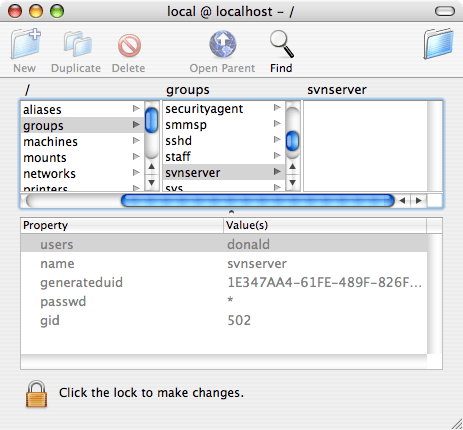Download Svn Server For Mac
Jul 02, 2020.
Find packages for your operating system:
Centos Linux Debian Linux Fedora Linux FreeBSD HP-UX NetBSD OpenBSD openSUSE Mac OS X Red Hat Linux Solaris SUSE Linux Ubuntu Linux Windows
The Apache Subversion project does not officially endorse or maintain any binary packages of the Subversion software. However, volunteers have created binary packages for different distributions and platforms, and as a convenience, we maintain a list of links to them here. If there are any problems with or questions about the different binary packages please send email to the Subversion users mailing list.

Note that binary packages usually come out about a week after the corresponding source release. Please don't post to the mailing lists asking when a binary package for a given platform will be ready. The packagers already know when new source releases come out, and work as fast as they can to make binaries available.
Binaries are typically built from the latest stable release.
Note also that this list does not include distributions of larger collections of software of which Subversion is but one piece. Several vendors offer such things, but we concern ourselves primarily with Subversion itself. As such, the listing here is limited to those packages which may be reasonably considered binary distributions of Apache Subversion alone. If you are looking for more widely scoped, Subversion-related value-add offerings, we trust that ${YOUR_FAVORITE_SEARCH_ENGINE} can facilitate that for you.
Mac Install Svn
Centos Linux ¶
CentOS project (client and server)
CollabNet (supported and certified by CollabNet; requires registration)
WANdisco (supported and certified by WANdisco; requires registration)
Debian Linux ¶
Debian Project (maintained by Debian Project; client and server; svnserve is part of the subversion package, mod_dav_svn is in the separate libapache2-mod-svn package (formerly libapache2-svn))
WANdisco (supported and certified by WANdisco; requires registration)
Fedora Linux ¶
FreeBSD ¶
HP-UX ¶
HP Porting Centre (maintained by Connect Internet Solutions Ltd.)
NetBSD ¶
OpenBSD ¶
OpenBSD Project (client and server; svnserve is part of the subversion package, mod_dav_svn is in the separate ap2-subversion package)
openSUSE ¶
Part of the the standard distribution. svnserve is part of the subversion package, mod_dav_svn is in the separate subversion-server package.
Community packages are available from the openSUSE project, also for the 1.8 series of releases.
Mac OS X ¶
An old version of Subversion is shipped with MacOS X. See the open source section of Apple's web site for more information.
Fink (requires Fink; maintained by Christian Schaffner)
MacPorts (requires MacPorts)
WANdisco (client and server; supported and certified by WANdisco; requires registration)
Red Hat Linux ¶
Red Hat (client and server)
CollabNet (supported and certified by CollabNet; requires registration)
WANdisco (supported and certified by WANdisco; requires registration)
Solaris ¶
WANdisco (supported and certified by WANdisco; requires registration)
SUSE Linux ¶
On SUSE Linux Enterprise: Enable the SDK. svnserve is part of the subversion package, mod_dav_svn is in the separate subversion-server package.
Community packages are available from the openSUSE project, also for the 1.8 series of releases.
WANdisco (supported and certified by WANdisco; requires registration)
Ubuntu Linux ¶
Ubuntu Packages (maintained by Ubuntu Project; client and server; svnserve is part of the subversion package, mod_dav_svn is in the separate libapache2-svn package)
WANdisco (supported and certified by WANdisco; requires registration)
Windows ¶
CollabNet (supported and certified by CollabNet; requires registration)
SlikSVN (32- and 64-bit client MSI; maintained by Bert Huijben, SharpSvn project)
TortoiseSVN (optionally installs 32- and 64-bit command line tools and svnserve; supported and maintained by the TortoiseSVN project)
VisualSVN (32- and 64-bit client and server; supported and maintained by VisualSVN)
WANdisco (32- and 64-bit client and server; supported and certified by WANdisco; requires registration)
Mac OS X Server 10.6 Snow Leopard
The following is a summary of recipes found on the Web, adapted to our site.
If not already done so, enable Web service in the General settings of your server.
Become root:
sudo -s.Create a folder holding the SVN repositories. We are using
/Volumes/Data2/Library/Subversion/Repository.In Terminal, create a new SVN repository, for example
svnadmin create /Volumes/Data2/Library/Subversion/Repository/basis.Finally, adjust ownership and permissions:
- Open Server Admin, select Web service.
Enable the dav_svn_module
Create a new site. We are using port 443 (SSL) here. Note: Either hostname or port must be unique in the list of sites hosted.
Enable WebDAV for the site under the options tab.
Enable SSL under the Security tab.
Define a WebDAV realm for the repository. Click the Plus button under the left-hand list in the Realms section and edit the corresponding entries as shown here.
Using the Plus button under the list on the right-hand side, add users and groups, giving them read and write permissions. Make sure that the permissions of the group Everyone is set to None.
- Click Save to save the new site. Do not yet start or restart Web service.
Back in Terminal, edit /etc/apache2/sites/0001_any_443_svn.cpfs.mpg.de.conf. In the /svn/ location block near the end of the file, insert the lines
Save your changes, return to Server Admin, and start or restart Web service.With Safari, connect to https://svn.cpfs.mpg.de/svn/basis/. After accepting the certificate and authenticating with the server, you should see something like this:
Caveat: If you apply further modifications to the SVN site just created using Server Admin, it might happen, that the line DAV yes in the configuration file is set to DAV no. Just in case there are problems with the access to the repository, correct this mistake and restart Web service.
